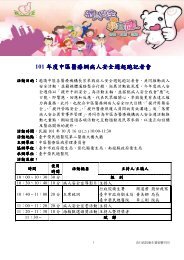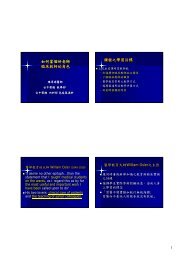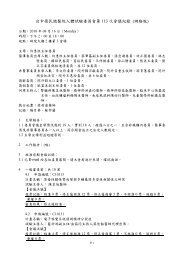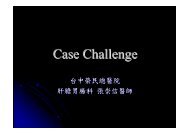å°å å¼å¸å¨åºæ¬è¨å®åå - å°ä¸æ¦®æ°ç¸½é«é¢
å°å å¼å¸å¨åºæ¬è¨å®åå - å°ä¸æ¦®æ°ç¸½é«é¢
å°å å¼å¸å¨åºæ¬è¨å®åå - å°ä¸æ¦®æ°ç¸½é«é¢
Create successful ePaper yourself
Turn your PDF publications into a flip-book with our unique Google optimized e-Paper software.
小 兒 呼 吸 器 使 用 的 基 本 原 則台 中 榮 民 總 醫 院 兒 童 加 護 中 心林 明 志 醫 師
機 械 呼 吸 的 基 本 術 語– IMV mode: 機 器 每 分 鐘 給 予 一 定 次 數 的 呼吸 , 但 在 這 些 固 定 的 呼 吸 之 間 , 病 人 可 以 自 行呼 吸 , 所 以 是 理 想 的 呼 吸 方 式 之 一 。– SIMV mode: 和 IMV 相 同 , 但 可 和 病 人 的 自 發性 呼 吸 同 步 化 而 不 相 拮 抗 。
機 械 呼 吸 的 基 本 術 語– CPAP mode: 病 人 經 由 呼 吸 器 自 行 呼 吸 , 呼吸 器 僅 提 供 氣 體 的 來 源 及 加 濕 , 但 在 呼 氣 終 了時 , 機 械 裝 置 會 使 氣 道 壓 力 高 於 大 氣 壓(PEEP)。– I/E ratio: 是 指 呼 氣 時 間 和 吐 氣 時 間 的 比 值 。在 正 常 情 形 下 ,I/E 比 值 約 為 1:2, 臨 床 上 常 用到 所 謂 I/E 比 值 倒 轉 , 是 指 I/E 比 值 大 於 1:1 的特 殊 情 形 。
機 械 呼 吸 的 基 本 術 語– 呼 氣 末 端 陽 壓 (end-expiratory exhalationpressure, PEEP):PEEP 是 一 種 機 械 上 的 技術 , 以 防 止 呼 吸 終 了 時 , 氣 道 壓 力 降 至 大 氣 壓相 同 的 程 度 , 以 防 止 肺 泡 塌 陷 。
需 求 式 及 連 續 式 氣 流(demand flow V.S. continuous flow)• 大 多 數 的 嬰 兒 呼 吸 器 使 用 連 續 性 氣 流 系統 , 病 人 可 以 在 任 何 時 間 內 吸 到 氣 體 , 如本 院 目 前 採 用 之 VIPbird,Newport 系 統 。而 所 謂 需 求 式 氣 流 , 是 指 機 械 必 須 感 應 到病 人 的 吸 氣 需 求 時 才 供 應 氣 流 , 如 果 無 法感 應 到 , 則 病 人 吸 不 到 氣 體 , 如 本 院 目 前採 用 之 Servo 系 列 。
Mechanical ventilatorclassification• Control• Cycling• Triggering• Breaths• Flow Pattern• Mode or Breath Pattern
Control• 指 呼 吸 器 如 何 知 道 送 多 少 氣 流 進 入 :– Volume controlled (volume limited, volumetargeted) and pressure variable– Pressure controlled (pressure limited,pressure targeted) and volume variable– Dual controlled (volume targeted (guaranteed)pressure limited)
Control• Trigger – time, pressure, volume, flow• Limit – time, pressure, volume, flow• Cycle – time, pressure, volume, flow• Baseline – pressure
Cycline• 呼 吸 器 何 時 由 吸 氣 變 吐 氣– Time cycled: PC– Flow cycled: PS– Volume cycled: VC
Triggering• Time• Pressure• Flow
Breaths are either...• Mandatory (controlled): CMV rate• Assisted (e.g.: A/C, SIMV, PS)• Spontaneous (CPAP)
常 用 呼 吸 器 mode 的 基 本 介 紹 :Control modesVolume Control Mode目 的 : 提 供 預 設 的 通 氣 量 , 以 預 設 的 呼 吸 速 率 及 吸 氣 時 間給 予 , 與 病 人 本 身 肺 的 阻 力 或 是 compliance 無 關 。應 用 : 提 供 肺 部 正 常 因 其 他 原 因 如 開 刀 麻 醉 的 病 人 使 用 。特 色 : 恆 定 的 流 速 , 符 合 一 般 生 理 狀 態 。
Pressure Control Mode目 的 : 提 供 吸 氣 期 恆 定 的 壓 力 , 避 免 不 必 要 的 高 氣 道 壓 力 , 遞 減 的 flowrate, 可 以 控 制 呼 吸 速 率 及 I/E ratio。應 用 : 一 般 用 在 無 自 主 呼 吸 的 病 人 , 為 兒 童 較 常 用 的 control mode。 應用 於 使 用 沒 有 cuff 氣 管 內 管 或 是 氣 管 內 管 有 漏 氣 情 形 的 病 人 。Asthma, lung injury, COPD, bronchospasm 的 病 人 。 或 是 某 些 需要 一 開 始 較 高 flow 使 肺 葉 張 開 的 病 人 , 某 些 需 要 避 免 高 氣 道 壓 力 的 病人 。
Pressure-regulated volume control (PRVC)目 的 : 提 供 預 設 的 通 氣 量 , 以 預 設 的 呼 吸 速 率 及 吸 氣 時 間 給 予 , 同 時 提供 吸 氣 期 恆 定 的 壓 力 , 遞 減 的 flow rate, 可 以 控 制 呼 吸 速 率 及 I/Eratio。 並 在 最 低 的 PIP 下 提 供 預 設 的 通 氣 量 。應 用 : 可 以 用 在 lung injury,asthma, COPD, 開 完 刀 的 病 人 , 兒 科 病人 , 需 要 一 開 始 較 高 flow 使 肺 葉 張 開 的 病 人 , 需 要 避 免 高 氣 道 壓 力 的病 人 。特 色 : 呼 吸 器 根 據 前 一 次 呼 吸 的 通 氣 量 , 自 動 調 整 PIP, 以 維 持 恆 定 的 通氣 量 。 呼 吸 的 型 態 接 近 pressure control, 但 又 兼 有 volume control 可控 制 分 鐘 通 氣 量 的 優 點 , 可 說 是 較 理 想 的 呼 吸 器 模 式 , 為 近 年 來 先 進呼 吸 器 發 展 的 趨 勢 。 唯 應 用 在 兒 科 病 患 , 若 是 氣 管 內 管 的 因 為 沒 有cuff, 而 有 較 顯 著 的 漏 氣 情 形 時 , 會 影 響 通 氣 量 的 測 量 , 較 不 適 用 。
常 用 呼 吸 器 mode 的 基 本 介 紹 :Weaning modesSIMV(PC)+pressure support目 的 : 在 吸 氣 期 間 以 一 定 的 氣 道 壓 力 , 提 供 部 分 的 強 制 呼 吸 。 可 藉 由 降 低 SIMV 的 次 數 , 來逐 步 脫 離 呼 吸 器 。應 用 : 用 於 一 些 有 一 部 份 自 主 呼 吸 , 但 是 不 夠 的 病 人 , 需 要 一 開 始 較 高 flow 使 肺 葉 張 開 的病 人 , 需 要 避 免 高 氣 道 壓 力 的 病 人 。 沒 有 cuff 氣 管 內 管 或 是 氣 管 內 管 有 漏 氣 情 形 的 病人 , 提 供 遞 減 的 flow rate。注 意 事 項 : 圖 形 中 SIMV period 是 由 機 器 上 的 SIMV cycle 來 決 定 (60/SIMV 秒 ), 而 SIMVperiod 是 由 CMV rate 決 定 (60/CMV 秒 )。 病 人 在 SIMV period 內 有 呼 吸 的 trigger, 他會 得 到 一 個 預 設 大 小 的 呼 吸 , 而 他 在 其 他 時 間 只 會 得 到 一 個 pressure support 的 , 或 是自 主 的 呼 吸 。
• SIMV(VC)+pressure support
Pressure support /CPAP:目 的 : 根 據 病 人 需 求 , 提 供 快 速 有 彈 性 的 呼 吸 協 助 , 以 利 脫 離 呼 吸 器 。並 監 視 病 人 之 呼 吸 狀 態 。應 用 : 用 在 呼 吸 drive 健 全 , 但 仍 需 要 部 分 機 械 協 助 , 或 是 需 要 CPAP 來維 持 換 氣 的 病 人 , 或 是 嘗 試 脫 離 呼 吸 器 的 病 人 。特 色 : 完 全 由 病 人 自 行 驅 動 , 無 保 證 的 通 氣 量 。
呼 吸 器 一 招 半 式 闖 江 湖• Mode– SIMV + PS• Rate (SIMV rate)– 30 for infants, up to 1 y/o– 20 for 1-6 y/o– 15 for greater than 6 y/o• PIP– 20 cmH 2 O• PEEP– +6-8 cmH 2 O for diseased lung, +4 cmH 2 O for normallung– 特 殊 狀 況 要 low PEEP (e.g. Glenn shunt or Fontanprocedure)
呼 吸 器 一 招 半 式 闖 江 湖• i-Time– LBW infant 0.25 ~ 0.5 seconds– Term infant 0.5 ~ 0.6 seconds– Toddler 0.5 ~ 0.75 seconds– Children 1.0 ~ 1.5 seconds– Adults 1.0 ~ 2.0 seconds• I/E ratio– 不 小 於 1 , 一 般 1:2 or 1:3
呼 吸 器 一 招 半 式 闖 江 湖• FiO2– 0.4 for normal lung– 0.9 for diseased lung (100% oxygen inducinglung collapse)• Tidal volume– 10 cc/kg (8-12) for normal lung– 6-8 cc/kg for diseased lung (ARDS)
呼 吸 器 調 整• 血 氧– FiO2– PEEP– I/E ratio• 二 氧 化 碳– RR– TV (PIP)
Acute Respiratory DistressSyndrome in ChildrenMing-Chih Lin M.D.Pediatric Intensive Care Unit & Division of Pediatric CardiologyTaichung Veterans General Hospital
What is ARDS?• First described by Ashbaugh et al. in 1967,Lacet 1967; 2(7511): 319-23• American-European ConsensusConference– Acute onset of respiratory symptoms– Frontal CXR with bilateral infiltrate– No clinical evidence of left atrial hypertension(Am J Respir Crit Care Med 149; 818-24, 1994)• No Gold Standard for diagnosis
AECC CriteriaTimingOxygenationFrontalCXRPul. A. wedgepressureAcute LungInjuryAcutePaO 2/FiO 2
EtiologyIndirect InjurySepsisMajor TraumaMultiple blood transfusionPancreatititsCardiopulmonary bypassDrug overdoseAdverse effect of medicationDirect InjuryPneumoniaAspirationPulmonary contusionToxic inhalationNear drowningReperfusion injury (e.g. postlungtransplantation)Mason: Muray & Nadel’s Textbook of Respiratory Medicine, 4th ed.
Role of neutrophils in thepathogenesis of acute lung injury.Activated neutrophils exit thebloodstream andtransmigrate across the alveolarcapillarymembrane, releasingcytokines, proteases, reactiveoxygen species, and othercompounds. Although crucial tohost defense against pathogens,the compounds secreted orreleased by the neutrophilhave the capacity to damage thetissue of the host. (Adapted fromLee WL, Downey GP: Leukocyteelastase: Physiologicalfunctions and role in acute lunginjury. A state of the art review.Am J Respir Crit Care Med164:896–904, 2001.)
Ventilator Strategy for ARDS• 6 mL/kg with PIP < 30 cmH 2 O compared with 12mL/kg PIP < 50 cmH 2 O– 22% reduction in mortality– Increased ventilator free day during the first 28hospital days– Adult patients(ARDS Network, NEJM 2000, 342: 1307-8)• Permissive hypercapnia– CO 2 allowed to rise– Maintain pH > 7.2 with buffered solution
ParameterModeTidal VolumePlateau pressureprotocolVolume assist-control≤6 mL/kg predicted body weight≤30 cm H2OFrequency 6–35 breaths/min, titrated for pH 7.30–7.45IE ratio 1:1 to 1:3Oxygenation Goal PaO 2 55–80 mm Hg, or SaO 2 88–95%FiO2/PEEP (cmH2O)combination allowedWeaning0.3/5, 0.4/5, 0.4/8, 0.5/8, 0.5/10, 0.6/10,0.7/10, 0.7/12, 0.7/14, 0.8/14,0.9/14, 0.9/16, 0.9/18, 1.0/18, 1.0/20, 1.0/22,1.0/24By pressure support, required whenFIO2/PEEP ≤ 0.4/8(ARDS Network, NEJM 2000, 342: 1307-8)
Sepsis台 中 榮 總 兒 童 醫 學 部林 明 志 醫 師
Systemic InflammatoryResponse Syndrome (SIRS)InfectionNon-infection disease(e.g., acute illness ortrauma)Tissue injuryAdequatesupportInadequateresuscitationExcessiveInflammationRecoverySystemic inflammatoryresponse syndrome (SIRS)and multiorgan dysfunctionsyndrome (MODS)
定 義• SIRS: >=2 criteria– 發 燒 Core Temp > 38.5 or < 36 ℃– 心 跳 加 速 Unexplained tachycardia or bradycardia < 1 y– 喘 Tachypnea or mechanical ventilation for an acuteprocess– 白 血 球 降 低 或 上 升 band form• Leukopenia or 10% immature neutrophiles• Sepsis: 感 染 相 關 的 SIRS• Severe sepsis:– Cardiac vascular dysfunction– ARDS– >= 2 organs dysfunctions• Septic shock:– sepsis and cardiovascular organ dysfunction
JAMA 1995; 273: 117
2008 戰 勝 敗 血 症 , 黃 金 六 小 時N engl J Med 2001: 345: 1368
9. Initiate empiric broad spectrum and adequate doseantibiotics therapy10. Start early goal-directed treatment for shockGoals: MAP > 65 mmHg, ScvO2>70%Urine output > 1 ml/kg/h11. Fluid supplement to target CVP as neededCVP→ 8-12 mmHg (12-15 mmHg if intubated)Push NS or colloid 20 ml/kg first, repeated over 60cc/kg as needed12. If MAP still < 65 mmHg after adequate fluid supplement:1 st line Dopamine 5-20 mcg/kg/minDobutamine 2-20 mcg/kg/min (if low cardiac output and elevated systemic vascular resistance states)2 nd line Levophed 0.5-2 mcg/kg/min, orEpinephrine 0.04-0.2 mcg/kg/min第 一 小 時1. Monitor ECG, SpO2, NIBP2. Consider intubation and mechanical ventilation ifrespiratory failure3. Artery-line placement & ABP monitor4. Placement of a CVP catheter (PreSep CVP with ScvO2 is preferred)5. Obtain smear and related culturesObtain 2 or more blood culture(Previous colonized fungus → fungus culture)6. Check CBC+DC, INR/PTT, AST, ALT, Bil T/D, Glu, electrolytes, BUN/Cr,CRP or Procalcitonin as needed7. Check chest x-ray or other image study as needed8. Check ABG, electrolytes, and lactate
1-6 hour1. Ongoing early goal-directed treatment for shock2. If shock is refractory to vasopressor and inotropic,may use Solu-Cortef 50 mg/m 2 /24hr if at risk for absolute adrenal insufficiency, remember to taperdown steroid once the shock is resolved ( 小 兒 參 考 劑 量 2 mg/kg)3. If MAP > 65 mmHg, but ScvO2 < 70%Consider further fluid supplement as toleratedPRBC supplement for Hct < 30%4. If shock persisted, evaluate heart functionCheck cardiac echo, PiCCO, PAC, or CCO as needed5. Control blood sugar < 150 mg/dL5. Check ABG, electrolytes, and lactate as needed
6-24 hour1. Ongoing goal-directed treatment for shock2. Recheck ABG, electrolytes, and lactate as needed3. Remove source of infection if possibleSite:____________________________Intervention: _____________________4. Protective ventilation strategyIf PaO2/FiO2
24-48 hour1. Narrow antibiotics by available report and clinicalimprovement2. If clinical condition deteriorated, consult ID doctor3. Reassess removal of infection sourceSite:____________________________Intervention: _____________________4. RRT for acute renal failure5. Nutrition supportIf enteral feeding is allowed and condition improved (like shock resolved, lactate < 3 mmol/L),start enteral feedingTPN for NPO patients6. Analgesia and sedation as neededPerform daily interruption for continuous sedation7. Prevent DVT and PE in postpubertal children with severe sepsisLow risk - choose one of the followings,(1) heparin loading 2000U then 100 U/h IV t itration to keep aPTT > 50 sec, (2) compressingstocking, or (3) intermittent pneumatic compression deviceHigh risk - combine heparin and mechanical device8. Discuss advance care plan with patient & family9. IVIG may be considered in children with severe sepsis10. ECMO be limited to refractory pediatric septic shock and/or respiratory failure that cannot besupported by conventional therapies
血 行 力 學 之 支 持 治 療• 輸 液 治 療 :– Colloid v.s. crystalloid– CVP level• 心 肺 腎 不 好 :8 mmHg• 單 一 器 官 :10 mmHg• 器 官 正 常 :12 mmHg• 呼 吸 器 :12-15 mmHg
血 行 力 學 之 支 持 治 療• 升 壓 劑– MAP > 65 mmHg– dopamine, norepinephrine– Epinephrine– Vasopression (0.03 units/min), not for 1 st line• 避 免 低 劑 量 dopamine 保 護 腎 臟• 盡 快 放 置 arterial line• Dobutamine 提 高 cardiac output• 不 建 議 以 預 設 高 於 正 常 值 的 cardiac index 治 療病 人
呼 吸 照 護• Low tidal volume, limited peak and plateaupressure– Tidal volume 6 mL/kg– Peak pressure < 35 mmH2O– Plateau pressure < 30 mmHg• Permissive CO2 retention• PEEP• Prone position• Head up 30-45 degress• Pul. Artery catheterization not recommended• Limited fluid therapy
輸 血 的 原 則• 無 心 肌 缺 氧 , 組 織 血 液 灌 流 不 足 , 嚴 重 低血 氧 , 急 性 出 血 , 缺 氧 性 心 臟 病 , 乳 酸 血症 ,PRBC keep 7-9 g/dL• FFP 不 該 被 常 規 使 用 ,10-15 mL/kg• Plt < 5000/mm3, 5000-30000 若 有 出 血 風險 , 手 術 前 > 50,000
感 染 的 Issue
Crit Care Med 2006; 34: 1589
Crit Care Med 2006; 34: 1589
類 固 醇 使 用 的 時 機• Children with catecholamine resistanceand suspected or proven adrenalinsufficiency
Specialconsiderationin children
Ming‐Chih Lin M.D.
Controlled, Supported, andSpontaneous modes
A. Pressure and VolumeB. PressureC. flow/volumeD. Extra flow and extra breathE. timing
Basic function – anoverview
Trigger
Bias flowinfant 0.5 l/min, adult 2l/min
Trigger sensitivityauto‐triggering if sensitivitytoo highWeak effortVery weak effort
Green bar – flow triggeryellow bar – pressure triggerred – risk of self triggering
Start breath, O 2 breath,inspiratory hold, expiratory hold
Range 0‐20%Default 5%In seconds PS, VS, and BiventAdult 0 ~ 0.4 secInfants 0~ 0.2 sec
•This is the length of the breath i.e. the total cycle time of the mandatorybreath in SIMV (inspiration, pause plus expiration).•This is set in seconds within the range•Infants 0.5 ~ 15 seconds in half second steps•Adults 1 –15 seconds in one second steps•This default setting for infants is 1 second and for adults is 4seconds
Trigger Timeout• Maximum allowed apnea time in Automodebefore controlled ventilation is activated Infants 3‐7 seconds Adult 7‐12 seconds
Range 0‐50 cmH 2 O
1. Target ventilation1. Tidal volume, frequency, and i time2. Pressure level is constant, but automatically adapts insmall increments breath by breath to match the patient.3. Inspiration starts according to a present frequency orpatient trigger4. Expiration starts1. After termination of present i time2. If the upper pressure limit is exceeds
• Normal VC• Inspirationprematurelyinterrupted as the settidal volume isdelivered.• The patientmaintains a flow ratehigher than thecalculated targetvalue.• Patient maintains theincreased flow rateinto the expiratoryperiod.
• Preset tidal volume and constant flow• Inspiratory flow constant depends on user interface setting• Present frequency of patient trigger• If patient makes an inspiratory effort ventilator will switch to PSmode• Expiratory startsTidal volume is deliveredFlow returns to the set value and after the preset pause time,guaranteed at least 20% expirationUpper pressure limits exceeded
• Constant pressure• Volume depends on the set pressure level, i time,and patient’s lung mechanical property• Inspiration starts according to the presentfrequency or patient triggers• Expiration starts After termination of preset i‐time If the upper pressure limit is exceeds
• Target tidal volume by an adapted pressure support• Inspiratory pressure constant• Starts when patient triggers.• Expiration startsInspiratory flow decreases below a preset fraction of the peak flow(inspiratory cycle off)If the upper pressure limit is exceeded• Maximum time for inspirationInfants 1.5 secondsAdult 2.5 seconds
InspirationCycle‐off• Important for patient’s comfort and ventilator synchronization• A patient with expiratory resistance the Cycle‐off should be set toa high level• Expiration starts when:Inspiratory flow decreases to the pre‐set cycle‐off levelUpper pressure limit exceededFlow drops to a flow range between 25% of the peak flow and lower limitfor inspiratory cycle‐off and the spent time within the range exceeds 50%of the time spent in between the start of the inspiration and entering thisrange
• Preset inspiratory pressure level• Patient determines frequency and i‐time• Inspiration starts when patient trigger• Expiration startsWhen flow decreases to Cycle‐off levelUpper pressure limit exceeds• Maximum timeInfants 1.5 secAdult 2.5 sec
• Synchronized with patient’s breathing• If no trigger attempt within a time window equal to90% of the set breath cycle (breath cycle time)• The mandatory breath is defined by the basicsetting• The spontaneous/pressure supported breaths aredefined by the setting for Pressure Support.
References• Servoi ventilator system V. 1.2 Use’s Manual Siemens‐Elema AB, Electromedical SystemsDivision, 2002


